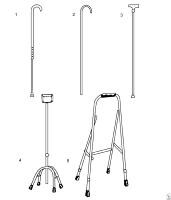Assistive devices for independence
are available to aid in mobility/ambulation (ambulatory aids),
activities of daily living (ADLs) and self-care, as well as for voice,
hearing, vision, and safety. Ambulatory aids (eg, canes, crutches,
walkers) are used to provide an extension of the upper extremities to
help transmit body weight and provide support for the patient. The image
below provides some examples of ambulatory aids.
 1: Adjustable aluminum cane. 2: Unadjustable aluminum cane. 3: T-top cane. 4: Quad cane. 5: Walk cane (hemi-walker). Assistive
devices for ADLs, as well as for self-care and leisure activities,
range from simple objects for daily use (eg, plate guards, spoons with
built-up handles, elastic shoelaces, doorknobs with rubber levers) to
complex electronic devices, such as voice-activated environmental
control systems.
1: Adjustable aluminum cane. 2: Unadjustable aluminum cane. 3: T-top cane. 4: Quad cane. 5: Walk cane (hemi-walker). Assistive
devices for ADLs, as well as for self-care and leisure activities,
range from simple objects for daily use (eg, plate guards, spoons with
built-up handles, elastic shoelaces, doorknobs with rubber levers) to
complex electronic devices, such as voice-activated environmental
control systems.
Cyberkinetics
 1: Adjustable aluminum cane. 2: Unadjustable aluminum cane. 3: T-top cane. 4: Quad cane. 5: Walk cane (hemi-walker). Assistive
devices for ADLs, as well as for self-care and leisure activities,
range from simple objects for daily use (eg, plate guards, spoons with
built-up handles, elastic shoelaces, doorknobs with rubber levers) to
complex electronic devices, such as voice-activated environmental
control systems.
1: Adjustable aluminum cane. 2: Unadjustable aluminum cane. 3: T-top cane. 4: Quad cane. 5: Walk cane (hemi-walker). Assistive
devices for ADLs, as well as for self-care and leisure activities,
range from simple objects for daily use (eg, plate guards, spoons with
built-up handles, elastic shoelaces, doorknobs with rubber levers) to
complex electronic devices, such as voice-activated environmental
control systems. Category
Assistive devices to improve independenceDevice details
Canes- C cane
- Functional grip cane
- Quad cane (narrow [small] based and wide [large] based)
- Walk cane (hemi-walker)
- Visual impairment cane
- Axillary (underarm) crutches
- Nonaxillary (forearm [Lofstrand, Canadian]) crutches
- Crutches with orthoses (wooden forearm orthosis, platform forearm orthosis, triceps weakness orthosis [Warm Springs crutch, Everett crutch])
- Four-point, 3-point, and 2-point gaits
- Swing-through gaits
- Swing-to gaits
- Drag-to (tripod) gait
- Standard (pickup) walker
- Rolling (4-wheeled) walker (with or without a seat)
- Front-wheeled walker
- Reciprocal walker
- Forearm support walker
- Stair-climbing walker
- Heavy-wheeled walker with foldaway seat and removable back
Cyberkinetics
- BrainGate
- BrainGate 2
- Neck electrolarynx
- Intraoral electrolarynx
No comments :
Post a Comment